Tyre width is one of the most hotly debated topics in road cycling.
Road cyclists traditionally used narrow tyres (23mm or smaller) because they were usually lighter and therefore assumed to be faster.
Recently, though, the trend has gone in the opposite direction. Manufacturers are encouraging road cyclists to use wider tyres (28mm or larger) amid claims they offer lower rolling resistance and a more comfortable ride quality.
But what tyre width is best for road cycling? To answer the question “are wider tyres faster?”, we devised two tests using a Pirelli P-Zero Race TLR tyre in two sizes: 700×26mm and 700×30mm.
These tyre widths were chosen to represent a standard, narrow road bike tyre width, as well as what most road cyclists would consider to be a fairly wide tyre.
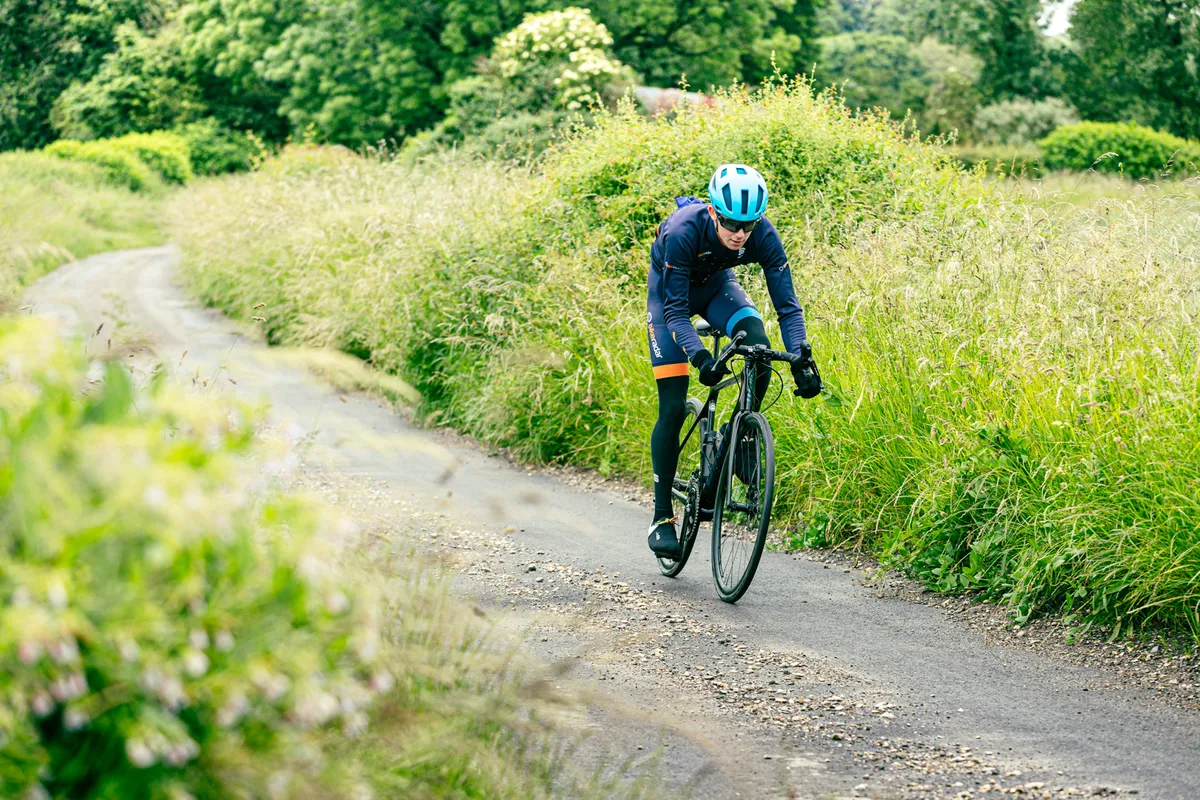
The first test was performed indoors on rollers, while the second was performed outdoors on a course that took in a variety of different road conditions.
The indoor testing should give us some solid data to detect any differences in rolling resistance between the narrow and wider tyres, but it’s also vital to assess the positives and negatives of each set of tyres in real-world conditions – which is where the second test comes in. Most of us actually ride our bikes in the real world, after all.
In our experience, when it comes to road bike tyre width, there’s a balance to be struck between comfort, rolling resistance and aerodynamics.
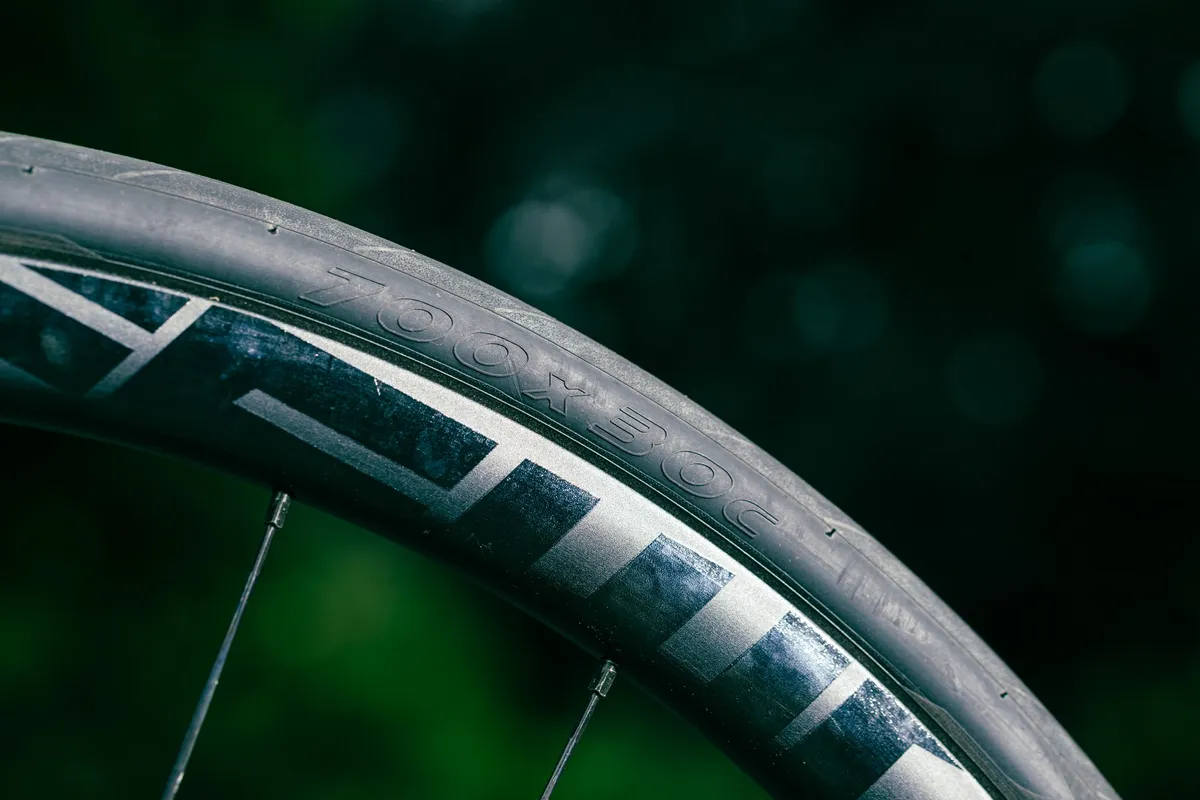
For example, wider tyres might be more comfortable, but using them may mean sacrificing a small amount of aerodynamic efficiency.
Where the balance lies for you will depend on your road bike and riding style, but we’ll give you our recommendations on how to choose the best tyre width to suit your needs.
Once you’ve read all of this, don’t forget to check out our guide to the best road bike tyres. We also have a buyer’s guide to the best tubeless tyres and, if you are thinking about ditching your inner tubes, here’s everything you need to know about tubeless setup.
Indoor roller testing
With so many variables at play, including wind and traffic, performing data-led testing outside in the real world can be a bit of a minefield.
Riding indoors on rollers, however, in a more controlled environment, can allow us to isolate the specific variables we want to test, which in this case is tyre width.
Indoor roller testing part 01: Tyre width
The test protocol is simple. Take two sets of identical tyres in different widths and ride on rollers at a fixed speed, for a fixed time interval. We then record the power required to maintain that speed.
Everything else – bike, wheelset, tyre type, riding position, etc. – will remain the same in each run. As will tyre pressure, with both the 26mm and 30mm tyres inflated to 90psi / 6.2bar.
If one tyre width is faster than the other, it should require a lower power output to maintain the target speed. We can then deduce that tyre width produces less rolling resistance.
In this test, the target speed was 40kph and the interval time was 5 minutes.
Prior to starting each test interval, I performed a 5-minute warmup targeting an average speed of 40kph, to get all of the system elements up to a consistent operating temperature.
Each run was repeated twice and the results averaged to ensure consistency.
It’s important to acknowledge this test doesn’t exactly replicate riding in the real world because the surface of the rollers is much smoother than any road. Tyres also deform slightly differently on rollers compared to roads, as the smaller diameter of the roller exaggerates the deformation of the tyre.
Nevertheless, it still provides a way to do controlled testing and isolate the effects of changing specific variables, such as tyre width.
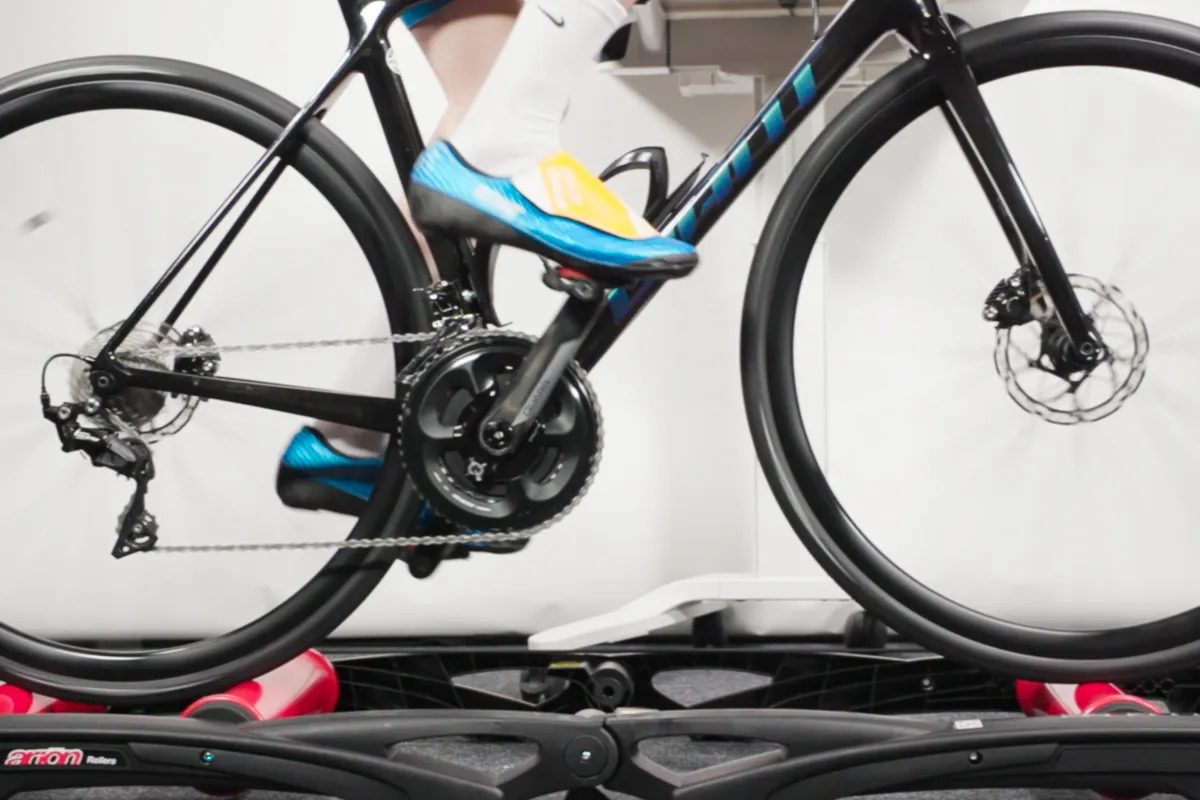
All test runs were performed on a Giant TCR Advanced Pro 2 Disc road bike with a FFWD F3AD clincher wheelset.
As already mentioned, the tyre model used for testing was Pirelli’s P-Zero Race TLR, in 700×26mm and 700×30mm sizes. The construction and rubber compound of the tyres is exactly the same, the only difference was the width of the tyres.
Though the tyres are tubeless-ready, we tested them set up with butyl inner tubes (the same inner tubes were used in both sets of tyres) to make swapping between tyres easier.
This will have added a small amount of rolling resistance to the wheel and tyre system in both cases, compared to setting them up tubeless, but any relative differences between the two tyre widths would not have been affected.
Power was recorded using a set of Favero Assioma Duo power meter pedals, which were calibrated (zero-offset) at the beginning of testing.
Results
| | Run 01 | Run 02 | Run 03 | Run 04 |
|---|---|---|---|---|
| Wheelset | FFWD F3AD | FFWD F3AD | FFWD F3AD | FFWD F3AD |
| Tyre model | Pirelli P-Zero Race TLR | Pirelli P-Zero Race TLR | Pirelli P-Zero Race TLR | Pirelli P-Zero Race TLR |
| Tyre size | 700x30mm | 700x30mm | 700x26mm | 700x26mm |
| Target speed | 40kph | 40kph | 40kph | 40kph |
| Warm up time | 00:05:00 | 00:05:00 | 00:05:00 | 00:05:00 |
| Lap time | 00:05:00 | 00:05:00 | 00:05:00 | 00:05:00 |
| Tyre pressure (psi/bar) | 90 / 6.2 | 90 / 6.2 | 90 / 6.2 | 90 / 6.2 |
| Lap avg power (watts) | 153 | 151 | 167 | 165 |
| Lap distance (km) | 3.34 | 3.34 | 3.33 | 3.35 |
| Lap avg speed (kph) | 40.1 | 40.1 | 40 | 40.2 |
| Results | ||||
| Tyre size | 700x30mm | 700x26mm | Difference | |
| Avg power at equal pressure (watts) | 152 | 166 | 14 |
Riding on the rollers at 40kph with the 30mm tyres required an average power output of 152 watts, compared to 166 watts with the 26mm tyres – a difference of 14 watts.
So wider tyres are a lot faster than narrow tyres, then? At the same pressure on a perfectly smooth surface, with no consideration for aerodynamics… Yes.
This is because, at the equal pressure, the casing tension of the wider tyre is higher and the contact patch is shorter and wider. The first of these factors means less energy is lost to casing flex, and the second reduces rolling resistance because the shorter, wider contact patch reduces frictional losses.
Case closed, then? I don’t think so. At this stage we’re missing a key point; this isn’t how we use wider tyres in the real world. Tyre pressure needs to come into play.
Indoor roller testing part 02: Tyre width and tyre pressure
When using wider tyres in the real world, we would typically not inflate them to the same pressure as a narrower tyre.
Doing so leads to a higher casing tension in the wider tyre, effectively making it stiffer and less comfortable than the narrower tyre.
A 30mm tyre inflated to 90psi / 6.2bar is, as you might imagine, extremely stiff. One of the benefits of using wider tyres is that they’re supposed to be more comfortable, but if the tyre pressure is too high then we won’t get that benefit in the real world.
On perfectly smooth surfaces like rollers (or, indeed, a velodrome), higher tyre pressures and casing tensions reduce rolling resistance because less energy is lost to casing flex and the size of the contact patch is reduced.
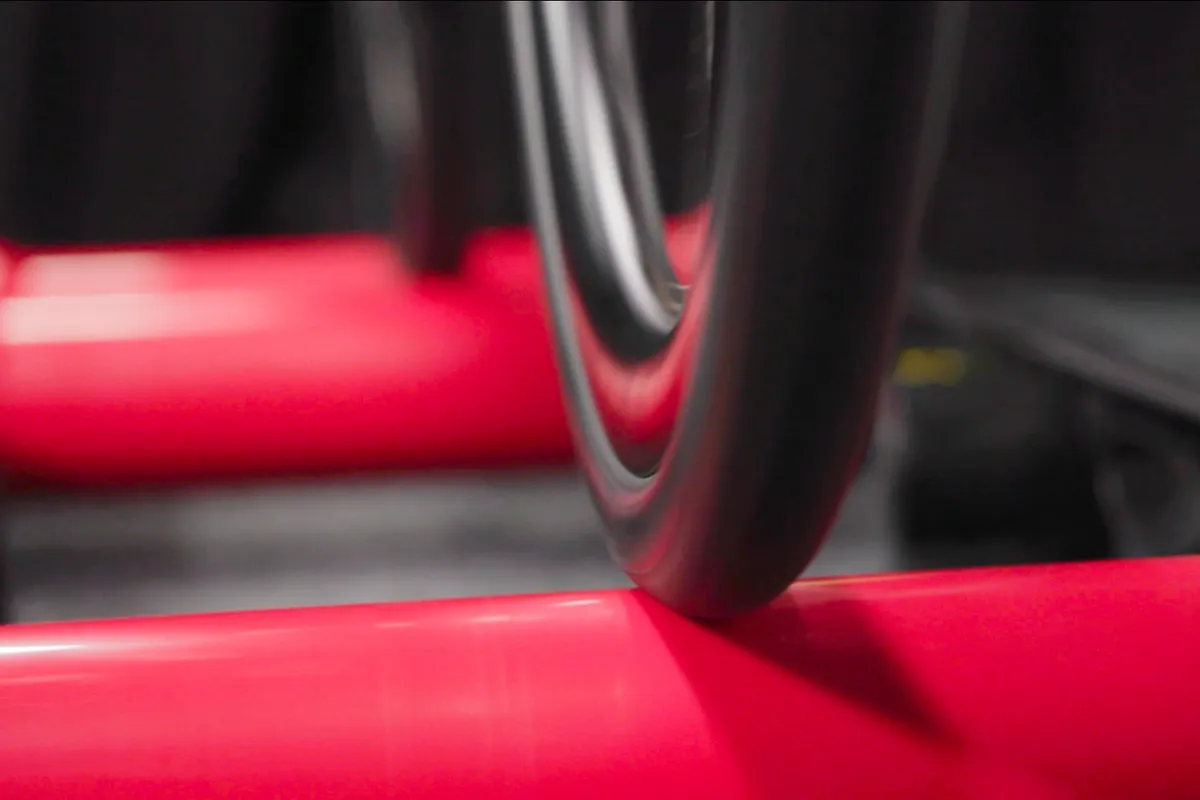
However, in the real world, where roads aren’t as smooth as rollers, wider tyres need to be inflated to lower pressures than narrower tyres because we want the casing to flex and absorb imperfections in the road surface. If we over-inflate our tyres, the bike will bounce over these imperfections, which ends up decreasing grip and speed.
Therefore, in the second part of the roller testing, we adapted tyre pressure in line with tyre size. That means a lower inflation pressure for the wider tyre and higher pressure for the narrower tyre.
Not only should this more accurately reflect real-world usage conditions, but it should also neutralise any rolling resistance advantage coming from increased casing tension on the wider tyre.
According to Pirelli’s recommendations, at a weight of around 64kg, I should be running the 26mm tyres at 83psi / 5.72bar and the 30mm tyres at 65psi / 4.48bar, so those are the pressures we tested at for this part of the test.
Results
| | Run 05 | Run 06 | Run 07 | Run 08 |
|---|---|---|---|---|
| Wheelset | FFWD F3AD | FFWD F3AD | FFWD F3AD | FFWD F3AD |
| Tyre model | Pirelli P-Zero Race TLR | Pirelli P-Zero Race TLR | Pirelli P-Zero Race TLR | Pirelli P-Zero Race TLR |
| Tyre size | 700x26c | 700x26c | 700x30c | 700x30c |
| Target speed | 40kph | 40kph | 40kph | 40kph |
| Warm up time | 00:05:00 | 00:05:00 | 00:05:00 | 00:05:00 |
| Lap time | 00:05:00 | 00:05:00 | 00:05:00 | 00:05:00 |
| Tyre pressure (psi/bar) | 83 / 5.7 | 83 / 5.7 | 65 / 4.5 | 65 / 4.5 |
| Lap avg power (watts) | 165 | 165 | 170 | 170 |
| Lap distance (km) | 3.34 | 3.34 | 3.33 | 3.33 |
| Lap avg speed (kph) | 40.1 | 40 | 40 | 40 |
| Results | ||||
| Tyre size | 700x30mm | 700x26mm | Difference | |
| Avg power at real world pressure (watts) | 170 | 165 | -5 |
At recommended riding pressures, riding on the rollers with 30mm tyres required an average power output of 170 watts, compared to 165 watts for the 26mm tyres.
Now the tables have been turned and the 26mm tyres apparently have a 5-watt advantage. Again, on a perfectly smooth surface with no consideration for aerodynamics.
So how is the narrower tyre suddenly producing less rolling resistance than the wider tyres? Again, it’s to do with casing tension and how the tyre pressure affects the size and shape of the contact patch.
A 26mm tyre inflated to 83psi / 5.72bar is noticeably stiffer than a 30mm tyre at 65psi / 4.48bar, leading to less casing flex and a smaller contact patch with the rollers.
This also means the 30mm tyres compress more under the weight of the bike and my body, increasing losses from casing flex and increasing the size of the contact patch.
If we were to precisely adapt the tyre pressure in each tyre size to give the exact same casing tension or stiffness, rolling resistance would likely be identical.
Roller testing conclusions
In the end, then, our roller testing shows that wider tyres do produce less rolling resistance than narrower ones at equal pressures.
Once we adjust for real-world riding pressures, however, that advantage disappears.
Real-world riding is important here because, ultimately, that’s how we’re using our bikes, so let’s take a closer look at some of the factors at play and how they might influence choosing the best tyre width for your bike.
What about riding in the real world?
Most people tend to ride their bikes outside on actual roads, so clearly the roller tests can’t tell us the whole story.
Though there may not be much difference in performance between narrow and wide tyres on rollers, experience tells us that wider tyres may improve comfort and, by reducing losses as a result of a stiff tyre skipping over imperfections, performance whenever the roads are less than perfect (which is often the case).
Suspension and grip
In the real world, road bike tyres need to act as suspension, absorbing – rather than bouncing over – imperfections in the road surface. This helps keep the rubber in contact with the ground for maximum speed, comfort and grip.
To enable this, tyre pressures should be reduced as roads get rougher. But, on very rough roads, a tyre that is too narrow may not have enough volume to absorb big bumps and still prevent the tyre from bottoming out.
In instances like this (hitting a pothole, for example), the tyre gets squashed between the rim and the obstacle, which can damage tyres, rims and inner tubes, potentially causing a pinch flat puncture (if you’re running inner tubes).
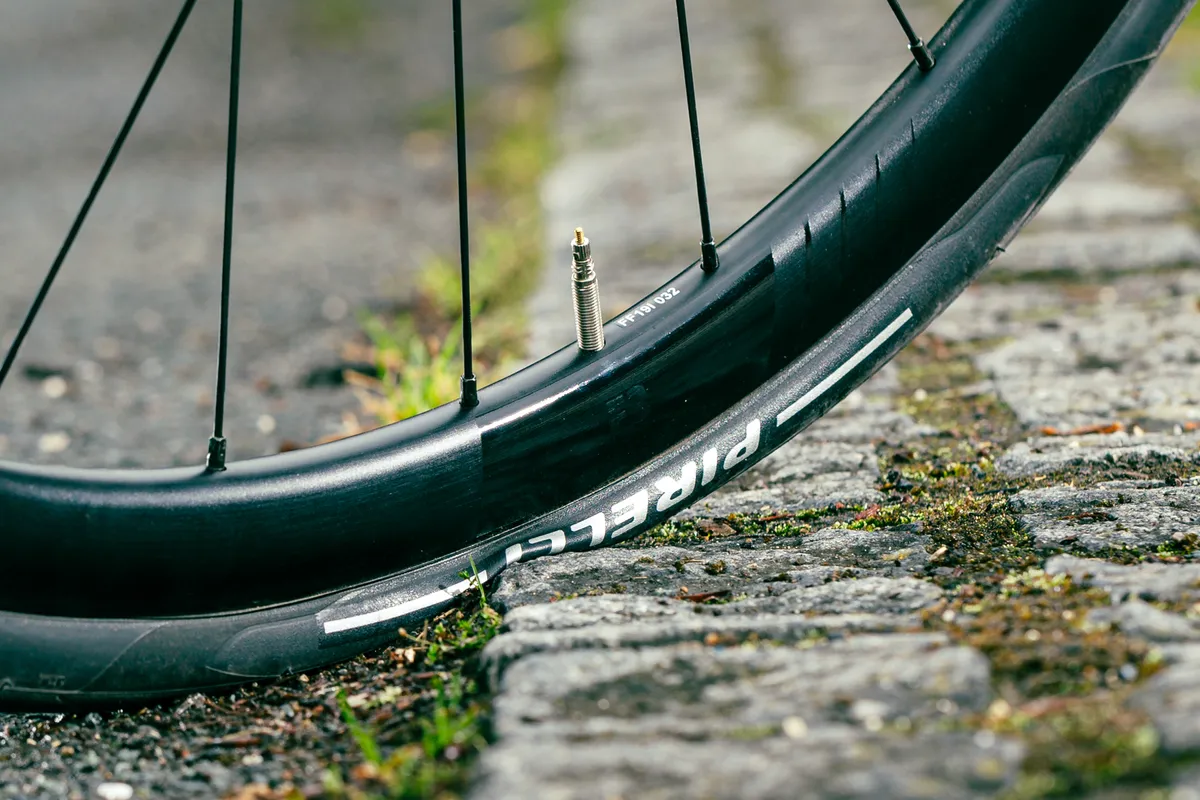
This issue can be exacerbated for heavier riders and bikes because they exert more downwards pressure on their tyres.
With this in mind, Pirelli, for example, recommends riders who weigh over 96kg (or are carrying loads that bring their total system weight to this level) should not use tyres smaller than 700×25mm.
Aerodynamics
On the other hand, on good surfaces (where lower levels of suspension are needed), a narrower tyre may provide a small aerodynamic advantage, due to the small decrease in frontal area.
Many modern aerodynamic road bike wheels are designed to work at their optimum (lowest aero drag) with 25mm tyres, but it's worth checking what tyre size your wheelset is optimised for.
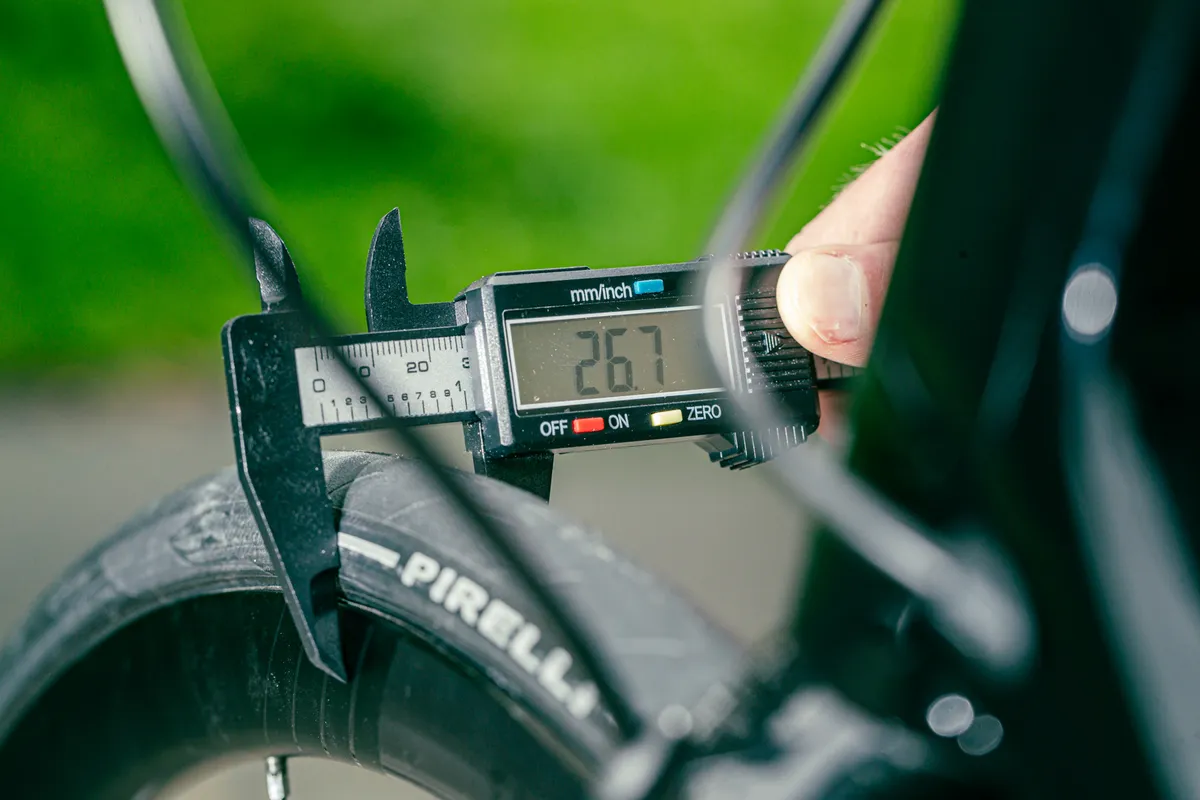
As a rule of thumb, you typically want the external rim width of the wheelset to be slightly wider than the tyres.
This is likely to be a worthwhile consideration only for those competing in time trials or road races on good roads, however.
Overall, the trick is to find a tyre size that balances suspension, grip and aerodynamics.
If you’re riding at slower speeds on rough roads, then suspension and grip are the factors to prioritise, which means choosing wider tyres. On the other hand, if you’re riding on smooth roads at high speeds then the small aero benefit of narrower tyres might be worth having.
Real-world ride impressions
While roller data is indicative of the differences in rolling resistance between tyres in a controlled environment, performance on real roads is what ultimately matters for most people.
To gather some more subjective impressions, we also tested our two tyre sizes on a short, 2.7km looped course just south of Bristol, with a variety of different road surfaces.
The loop handily combines a newly paved climb, a descent on a stereotypical ‘normal’ UK road with cracks and imperfections, and a short, flat part in between the two that has sections of almost completely broken road.
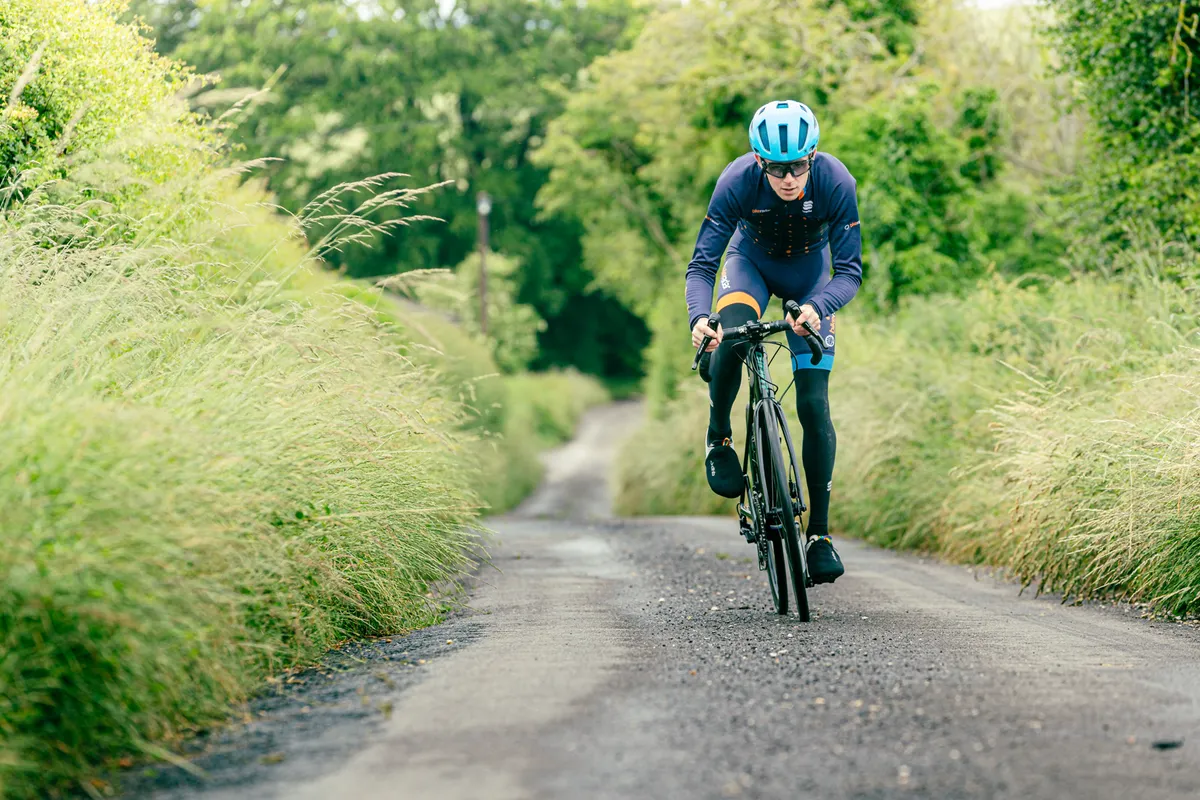
For this test, I used the same tyre pressures recommended by Pirelli for each tyre size, for my weight, which was 83psi / 5.72bar for the 26mm tyres and 65psi / 4.48bar for the 30mm tyres.
While we could have attempted to gather some data through timed laps ridden at a set average power, this testing was done on open roads, so it would be very difficult to remove the influence of rider and environmental variables.
Things like wind speed/direction, passing traffic and differences introduced through braking and line choice on each run, would all contribute noise to the data and lead to a fairly large margin for error.
This test was therefore less about gathering data and more about getting a feel for what it’s actually like to ride each tyre width back to back in the real world.
Real-world ride conclusions
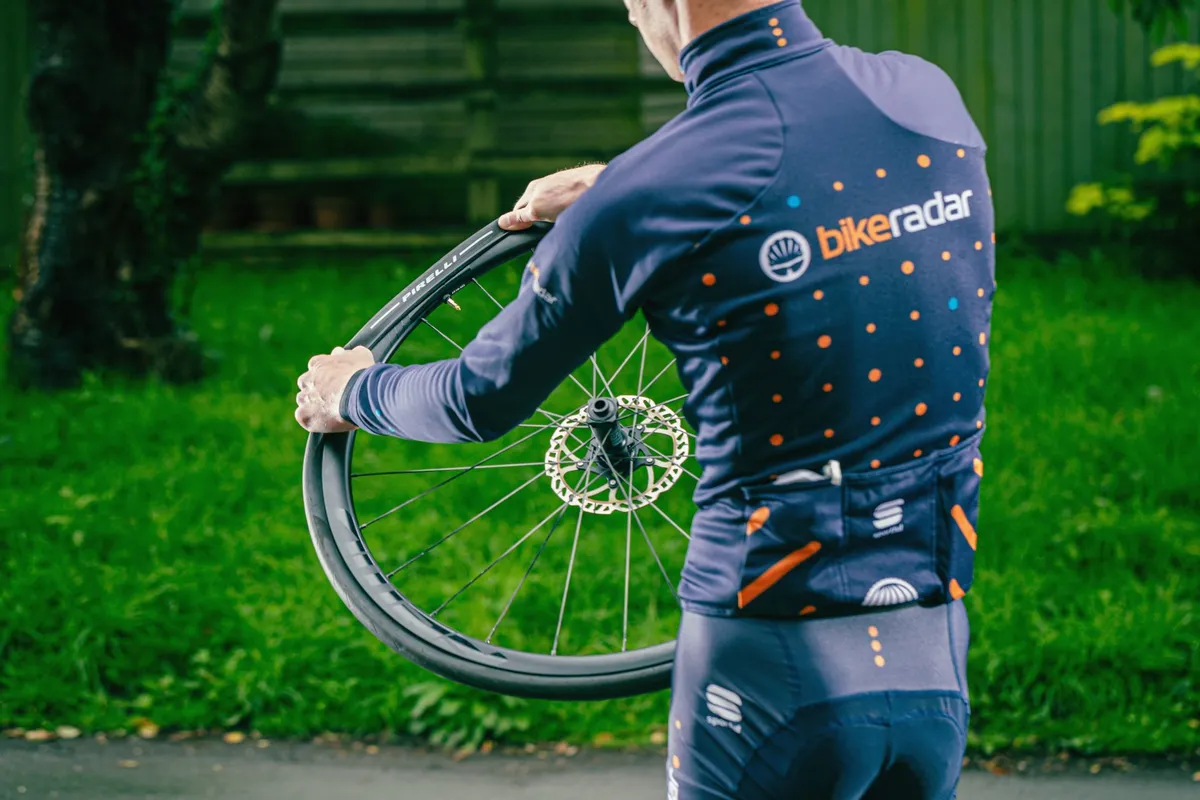
As expected, the differences between the two tyre widths on smooth tarmac were minimal.
On good roads, the increased volume of the wider 700×30mm tyres had little detectable effect in improving comfort over the 700×26mm tyres, but we know there is a small aero penalty.
As roads got rougher though, the comfort and grip benefits of the wider tyres became much more apparent very quickly.
Even on the section of ‘normal’ UK road, the wider tyre was noticeably more comfortable even on a short loop like our test course. On top of this, any time the road surface deteriorated significantly, the extra grip of the wider tyres was far more confidence-inspiring.
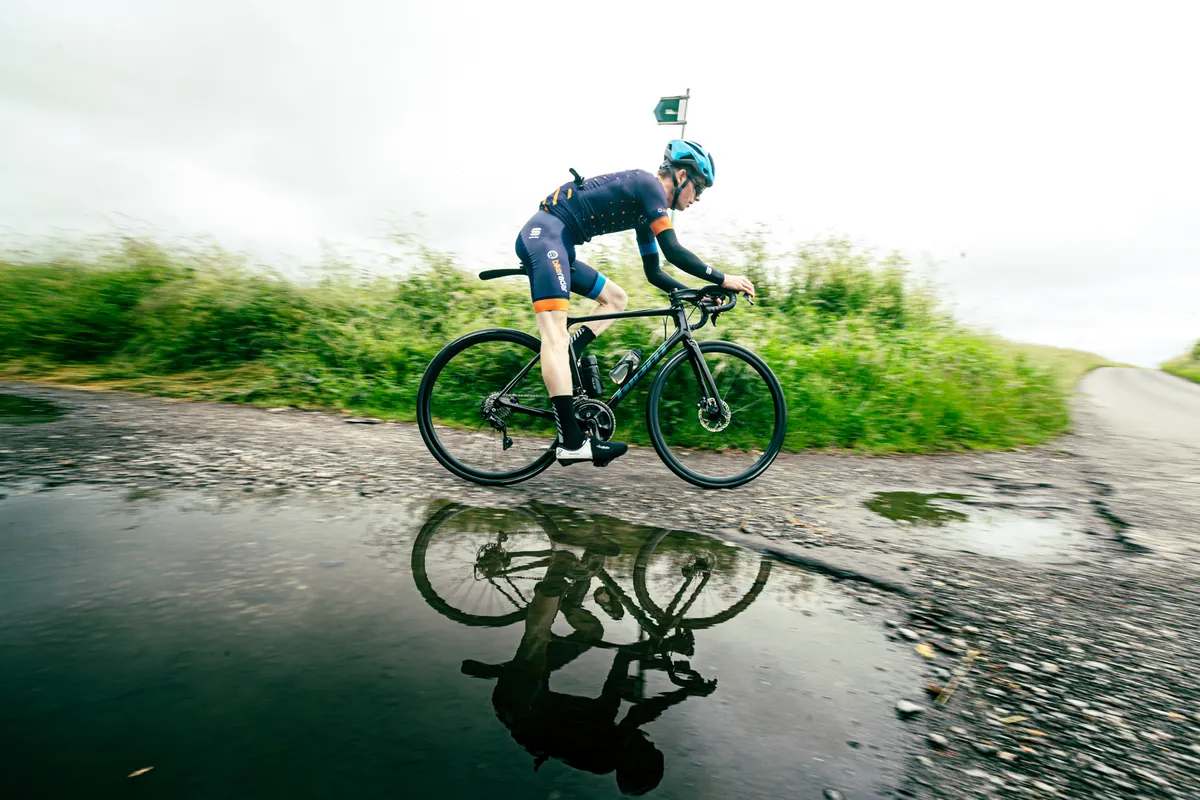
This is especially true on descents, where the larger tyres give a sensation of much greater control.
It’s important to note that while the narrow tyres might feel fast on rough roads, the high-frequency vibrations we experienced as the bike bounced over imperfections in the road are misleading.
As discussed in our guide to road bike tyre pressure, wider tyres at lower pressures can help keep the rubber in contact with the road more of the time, leading to lower rolling resistance.
What makes a fast tyre then?
This is a complicated topic, but the amount of rolling resistance a tyre generates is largely down to its construction and rubber compound (assuming it’s inflated to the optimum pressure).
In general, lighter tyres, with thinner, supple casings and low rolling resistance rubber compounds are usually faster than heavy, thick tyres with stiff casings and additional materials like puncture protection belts. Think summer tyres versus winter tyres.
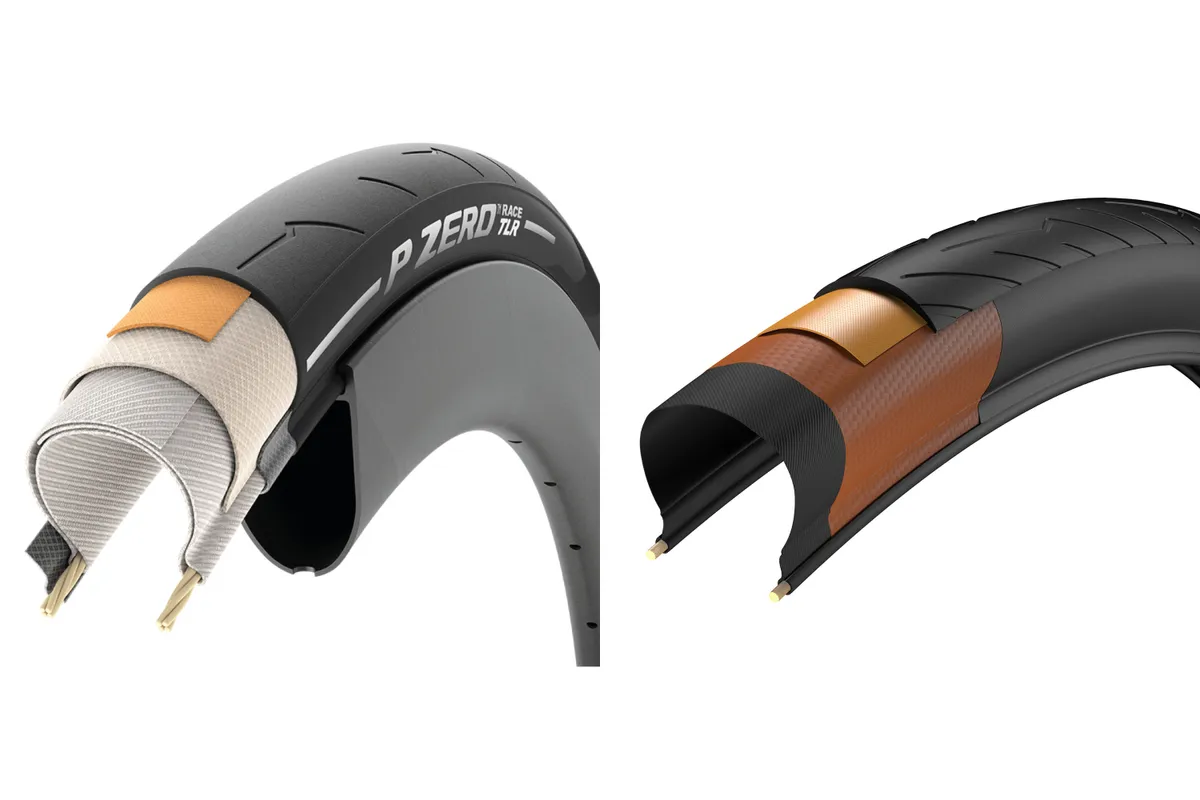
As you can probably guess then, there’s almost always a trade-off between speed and durability with road bike tyres. Exactly where the sweet spot lies will be different depending on what kind of riding you do.
Paper-thin, lightweight tyres are great for time trial racing on perfect roads but probably won’t stand up to an unplanned excursion on your local gravel trail or long days out on a winter club run.
What size tyres should you use?
Our roller testing shows that wider tyres exhibit a rolling resistance advantage over narrow ones at equal pressures. However, once you normalise for real-world riding pressures that advantage disappears.
In the real world, the answer to the question ‘are wider tyres faster?’ is more nuanced. Though wider tyres don’t produce less rolling resistance than narrower tyres once you normalise for casing tension, they shouldn’t roll any slower either.
Wider tyres are also likely to be more comfortable and grippier. A more comfortable, confidence-inspiring ride could well be faster overall too, depending on the terrain, and it’s certainly more enjoyable.
We can therefore choose our tyre width based on other criteria, such as suspension requirements, grip, and aerodynamics. Ultimately, you need to weigh up what you’re trying to achieve with your bike setup.
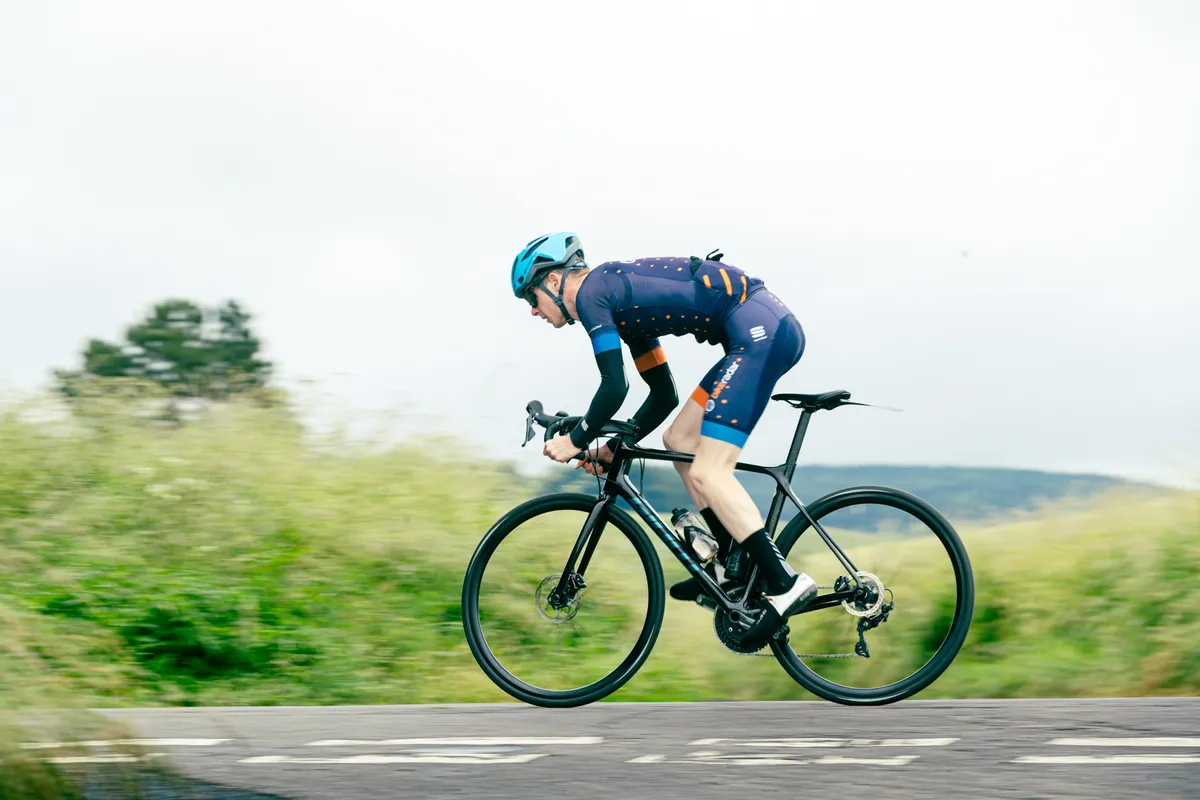
Providing your bike has enough clearance, we’d generally recommend a sweet spot of 28mm tyres as a good balance of all these characteristics for most UK-based riders – or, if like us, you live somewhere with less-than-perfect tarmac. If you have wheels with a modern, wide rim profile, there may not be much of an aerodynamic penalty, either.
If you take part in races or time trials on good roads, then a slightly narrower 25mm tyre may provide a small aerodynamic benefit at high speeds. But, if you’re racing on rough roads, going slightly wider is likely worth the small aero penalty.
If you regularly ride on particularly rough roads or want to take in some light gravel sectors, 30mm (or larger) tyres will likely provide you with greater comfort, grip and off-road control, with no impact on rolling resistance.

